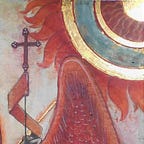The Absolute Reality and Islam
The text of this edition proposes a trip to the Middle East and an introduction to the fundamentals of Islamic art. I rectify, as usual, that there is no intention of proselytism, only in presenting part of the dogmatic argument that supports the Muslim visual creative manifestation. I will try to synthesize and justify the concepts that underlie the abstract nature of Sacred Art in Islam.
One of the main concepts that govern Islamic art is its aniconistic nature. Aniconism is the rejection of any visual representation as a means of worship; therefore, unlike Christianity, we do not find an “Islamic iconography”. Muslim Sacred Art is abstract par excellence. To illustrate what I mean, I would like to take the reader to Mecca, the sacred city of Islam. There, it is alleged that there is a cubic structure called Kaaba that was built by Abraham and his son Ishmael many years before the birth of the prophet of Islam. Naturally, in its genesis, the Kaaba was dedicated to the invisible God of Abraham, therefore, empty. As the centuries passed, this structure became full of idols that were offered by the many pilgrims who, in this way, defied its original intention. However, the presence of the idols is finally purged with the coming of the prophet Muhammad, making the Kaaba empty again. This is a very important allegory because it is the most sacred place of the Islamic faith. Millions of people make a pilgrimage to Mecca to come across this empty cubic structure, since the presence of God is absolute and irreducible to any idol or image.
Due to its Semitic heritage and as the newest of the Abrahamic religions, Islam takes a stern stance on the third commandment of the laws of Moses: “You will not make any idol for yourself, no carved image, nothing that resembles what exists there above, in the heavens, or below the earth, or even in the waters that are below the earth (…) ”. This aversion to visual representation is a mechanism to avoid idolatry and reduce the universal presence of God to something finite, tangible and ephemeral (as seen in the paragraph above). In comparison, inside the mosques, in parallel to the cathedrals, the space is abundant, plain. There are no altars or images that serve as vehicles for engaging with the presence of the Divine; the adornments are only architectural, geometric or calligraphic. This absence of image serves two purposes, as the art historian Titus Burckhardt explains: the first is to eliminate a “presence” that can oppose the “Ultimate Presence of God” (which, in itself, is invisible) and would compel the faithful to the error of idolatry; the other is precisely to expose the transcendence of God since his “Divine Essence” cannot be compared to absolutely nothing.
In Islam, the words “There is no god but God” (la ilaha illallah) is part of the conversion process called “Testimony” (shahadah). This phrase implies many layers of interpretation and among them, Martin Lings, Sufi master, works on this same idea as “There is no reality but the Ultimate Reality” and, when referring to an “Ultimate Reality”, containing it, even if symbolically, it is absolutely impossible. Therefore, in Sufism (in the esoteric perspective of Islam), we experience this “Ultimate Reality” through its minor manifestations, alluding to the term “Unity in Multiplicity” which is a fundamental concept for Sacred Geometry, since everything manifests from the single center of the circle and multiplies harmoniously through abstract patterns. Thus, Geometry is tremendously present and important in Islamic art, it alerts the abstract quality of God and understands that Creation manifests itself through geometric means.
I would like to bring a brief analysis of a simple geometric pattern called “The Breath of the Compassionate”, it is the overlap of two squares, forming an eight-pointed star, an octagram, which is repeated at all pegs. The negative space between an octagram and another forms a kind of cross. This brings to the composition a rhythmic sensation of breathing; when the shape inflates (the octagram), there is life, when deflating (the cross), it symbolizes the return, death. The two overlapping squares represent the union of two planes, the spiritual and the earthly; as well as the allegory of the Kaaba, which is cubic and physical, but overlapping, imbued with an invisible, abstract, spiritual dimension. To conclude, I would like to bring the following excerpt from the Sacred Text: “To Allah belong the east and the west, so wherever you turn you are facing ˹towards˺ Allah.1 Surely Allah is All-Encompassing,2 All-Knowing” (2: 115 Koran ).
